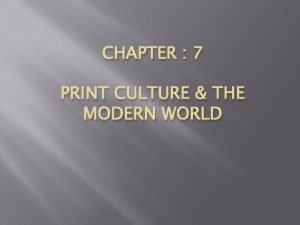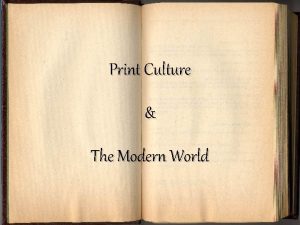Print culture and the modern world Print technology







- Slides: 7

Print culture and the modern world • Print technology was developed • • in China, Japan and Korea. Dimond Sutra was the first Japanese book printed by buddhist missionery. In the 11 th C. Chinese paper reached Europe. Marko-Polo brought woodblock printing knowledge to Italy. In Germany Johann Gutenburg first developed the printing press.

Print culture and the French Revolution • Print popularised the idea of Philosophers like • • Rousseau 8, Voltair. Print created a new culture of debate and dialogue. Literature raised question about the existing social order. Print helped to spread the ideas of the philosopher. People widely read it and influenced by their ideas. Print opened up the peoples mind to think differently.

Print and poor people • In 19 th c, very cheap and small books were to market. • From the early 20 th c, public libraries were set up mostly • • in towns, cities and prosperous villages. Jyotiba Phule wrote about the injustice of women in “Gulamgiri” in 1871. In the 20 th c, B. R. Ambedkar, E. V. Ramaswamy Naicar wrote powerfully about castism. Bengal millworkers set up libraries to educate themselves. Print culture helped to begin nationalism in India.

India and the world of Print • India had a rich and old tradition of handwritting • • • manuscript. In the mid 16 th c. Printing came to India with Partugueese Missioneries. In 1579 Cathelic priest first printed the Tamil book. In the late 17 th c. East India company Brought the first printing press to India. In 1780 James Augustus Hickey began to edit the “Bengal Gagette”. Gangadhar Bhattacharyaa was the first Indian who published the newspapper Bengal Gagette.

Religious reform and public debate • From the early 18 th centuary, there were • • • intense debate around religious issues. Some criticised existing practices and campainged for reformes. others countered the arguments of reformes. Rammohan Ray Published the “Sambad Kaumudi”. Hindu orthodox published the : chamachar Chandrika” to oppose his opinion. Persian and Gujrati newspaper were also published. Religious texts encouraged people to discussion, debate and controversies within and among different religions. Ulama published Persian and Urdu translations of Holy Scriptures and printed Religious News papers

NEW FORMS OF PUBLICATIONS • Novels and other literary books • • • published. It opened up a new world of experience. Lyries, short stories, essays were published in great numbers and they reinforced the new emphasis on human lives. Painters like Raja Ravi Verma produce images for mass circulation. By the 1670 s, Caricature and cartoons were published in journel s and newspapers.

WOMEN AND PRINT • • • Women’s reading increased in middle class homes. Liberal husbands and fathers began educating their womenfolk at homes. Many journals began carrying writings by women and explained why women should be educated. Hindus believed that a literate girl would be widowed. Muslims believed that educated women would be corrupted by reading Urdu romances. Rashsundari devi learnt to read in the secrecy of her home. She wrote her autobiography “Amar Jivan” which was published in 1876. Social reforms and novels created a great interest in women lives and emotions. Tarabai Shinde and Pandita Ramabai wrote with anger about the miserable lives of Upper caste Hindu women. A few Bangali women like Kailashbashini Devi wrote books highlighting the experiences of women about how women were imprisoned at home, kept in ignorance and forced to do hard domestic works. From 1870, Hindu print culture had developed. Urdu, Tamil, Bengali and Marathi print culture had already developed. By the early 20 th century, journals were popular. They discussed issues like women’s educations, widowhood, widow remarriage and the national movement.











